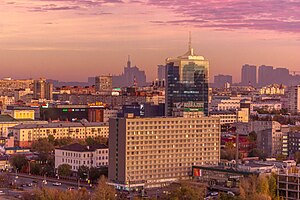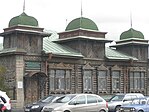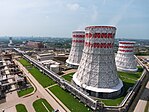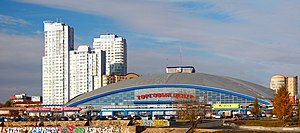
Back Tsjeljabinsk Afrikaans Челябинск ALT Chelyabinsk AN تشيليابنسك Arabic Tcelyabinsk AVK Çelyabinsk Azerbaijani چلیابینسک AZB Силәбе Bashkir Чалябінск Byelorussian Чалябінск BE-X-OLD
Chelyabinsk
Челябинск | |
|---|---|
|
From the top to the left: View of Chelyabinsk, Trinity Church, TDK Building, Ryabanin house, Fortum power plant, Trade center. | |
|
| |
| Coordinates: 55°09′17″N 61°22′33″E / 55.15472°N 61.37583°E | |
| Country | Russia |
| Federal subject | Chelyabinsk Oblast |
| Founded | 1736[2] |
| City status since | 1787[2] |
| Government | |
| • Body | Council |
| • Head | Natalya Kotova (acting) |
| Area | |
• Total | 530 km2 (200 sq mi) |
| Elevation | 220 m (720 ft) |
| Population | |
• Total | 1,130,132 |
• Estimate (2018)[5] | 1,202,371 (+6.4%) |
| • Rank | 9th in 2010 |
| • Density | 2,100/km2 (5,500/sq mi) |
| • Subordinated to | City of Chelyabinsk[1] |
| • Capital of | Chelyabinsk Oblast,[1] City of Chelyabinsk[1] |
| • Urban okrug | Chelyabinsky Urban Okrug[1] |
| • Capital of | Chelyabinsky Urban Okrug[1] |
| Time zone | UTC+5 (MSK+2 |
| Postal code(s)[7] | 454xxx |
| Dialing code(s) | +7 351[8] |
| OKTMO ID | 75701000001 |
| City Day | September 13 |
| Website | www |
Chelyabinsk[a] is the administrative center and largest city of Chelyabinsk Oblast, Russia. It is the seventh-largest city in Russia, with a population of over 1.1 million people, and the second-largest city in the Ural Federal District, after Yekaterinburg. Chelyabinsk is located to the East behind the South part of the Ural Mountains and runs along the Miass River.
The area of Chelyabinsk contained the ancient settlement of Arkaim, which belonged to the Sintashta culture. In 1736, a fortress by the name of Chelyaba was founded on the site of a Bashkir village. Chelyabinsk was granted town status by 1787. Chelyabinsk began to grow rapidly by the early 20th century as a result of the construction of railway links from the Russian core to Siberia, including the Trans-Siberian Railway. Its population reached 70,000 by 1917. Under the Soviet Union, Chelyabinsk became a major industrial centre during the 1930s. The Chelyabinsk Tractor Plant was built in 1933. During World War II, the city was a major contributor to the manufacture of tanks and ammunition.
In the 1990s and 2000s, a number of industries in Chelyabinsk ceased to exist due to the difficult economic situation,[10][11] As of the 2020s, it continues to experience difficulties in the areas of ecology, economic and economic spheres, and urban improvement. Nevertheless, it is one of the largest industrial centers of the Urals, where industry accounts for almost 40% of the gross municipal product, especially heavy industries such as metallurgy and military production. It is home to several educational institutions, mainly South Ural State University and Chelyabinsk State University.[12]
- ^ a b c d e f Cite error: The named reference
Ref30was invoked but never defined (see the help page). - ^ a b "Chelyabinsk - Russia". Retrieved 21 September 2017.
- ^ "Челябинск сегодня – Визитная Карточка". Администрация г. Челябинска. Archived from the original on 26 January 2012.
- ^ Russian Federal State Statistics Service (2011). Всероссийская перепись населения 2010 года. Том 1 [2010 All-Russian Population Census, vol. 1]. Всероссийская перепись населения 2010 года [2010 All-Russia Population Census] (in Russian). Federal State Statistics Service.
- ^ "26. Численность постоянного населения Российской Федерации по муниципальным образованиям на 1 января 2018 года". Federal State Statistics Service. Retrieved 23 January 2019.
- ^ "Об исчислении времени". Официальный интернет-портал правовой информации (in Russian). 3 June 2011. Retrieved 19 January 2019.
- ^ "Information about central postal office" (in Russian). Archived from the original on 3 March 2016.
- ^ "Russian Federation Cities dialing codes" (ZIP 34.4KB) (in Russian).[permanent dead link]
- ^ "Численность населения Российской Федерации по муниципальным образованиям на 1 января 2013 года. — М.: Федеральная служба государственной статистики Росстат, 2013. — 528 с. (Табл. 33. Численность населения городских округов, муниципальных районов, городских и сельских поселений, городских населенных пунктов, сельских населенных пунктов)". Archived from the original on 21 December 2021. Retrieved 8 February 2014.
- ^ "История Челябинска | Администрация г. Челябинска". History of Chelyabinsk. Administration of Chelyabinsk. Archived from the original on 22 December 2017. Retrieved 4 September 2023.
- ^ ""Good News of Chelyabinsk Region"". Top 10 Chelyabinsk enterprises that have turned into a shopping mall. Hornews. Retrieved 4 September 2023.
- ^ . Administration of Chelyabinsk (2020) https://translate.google.com/website?sl=auto&tl=en&hl=en&u=https://cheladmin.ru/sites/default/files/imceFiles/user704/pasport_na_sayt_0.pdf. Retrieved 4 September 2023.
{{cite web}}: Missing or empty|title=(help)
Cite error: There are <ref group=lower-alpha> tags or {{efn}} templates on this page, but the references will not show without a {{reflist|group=lower-alpha}} template or {{notelist}} template (see the help page).










